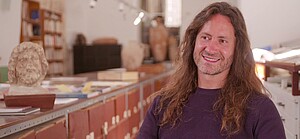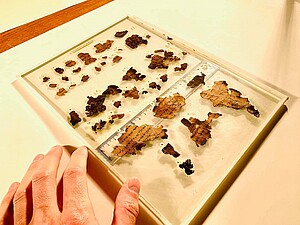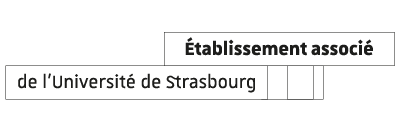From the study of the forged Dead Sea scrolls, which led to threats against him, to the partially preserved biblical scriptures of the Jerusalem libraries, Michael Langlois, a researcher at the Faculty of Protestant Theology, reflects on a busy career between Israel and France.
There was nothing about Michael Langlois that predestined him for the historical sciences. I first studied mathematics, IT, physics and chemistry until the first year of a Master’s
, recounts the researcher, who then switched to studying protestant theology, with an interest in the founding texts. They are the basis of theology
, explains Michael Langlois, whose particular interest is the Bible.
His investigations continued with doctoral studies in philology and historical science. This was followed by a thesis at the Sorbonne on a series of 12 Aramaic manuscripts from the 2nd century BC, discovered in the mid-20th century and conserved in Jerusalem. It was the Book of Enoch, a literary work of ancient Judaism, which is not found in our Bibles today but which is included in the Ethiopian Bible.
Michael Langlois is working on the publication of a bilingual edition of the manuscripts. The fifth is in progress.
It is a painstaking job that requires the comparison of the work with several later translations in Ethiopian and ancient Greek because of missing pieces. I checked to see if my additions were correct by imitating the scribe’s handwriting to see whether it was consistent with the length of the gap.
Prophetic texts on pottery
In order to acquire his authorisation to supervise research, the researcher then focussed on the Book of Joshua. It is an account in biblical Hebrew of military conquests, describing events from 1200 BC, of which the official text was only confirmed in 1000 AD. What happened in between?
, asks Michael Langlois, who discovered older manuscripts, in Hebrew, from the turn of our era. I was thus able to show that the Book of Joshua in antiquity did not yet have the same form as the one we have now. This raises the question of the editorial process of the Bible, given that at the time it was not yet decided which texts would be included in it.
When he isn’t in libraries, the researcher is on excavation sites in Israel. I’m currently working on the publication of texts found on pottery during my CNRS assignment to the Centre de recherche français in Jerusalem, from 2018 to 2020.
These were fragments of pottery from the 2nd century BC used as a writing surface as it was cheaper than papyrus or parchment. They aren’t great literary texts but many have survived because they are more durable.
There are around a hundred inscriptions in Hebrew and Aramaic, most of which are bookkeeping texts, but also some military and even some prophetic messages. It is all written in very compact, cursive handwriting, which is difficult to decipher. At the time, the religious component was everywhere, even in greetings. This work is helping us to understand who we have become over the centuries. What is striking is that we realise that we are still asking ourselves the same questions today.
“Shady international business”
Another big project was the fake Dead Sea Scrolls. Manuscripts obtained by looting arrived on the antiques market, some of which ended up in museums, but how could we know if they were genuine?
asks the researcher, who worked with a chemist and a mathematician to develop tools.
This research led to threats. I was contacted by a Norwegian collector who had acquired some manuscripts. I saw that they were forgeries from an antiques dealer in Bethlehem. The matter became more serious when a businessman connected to the antiques dealer contacted us to ask us to keep quiet. I received threats. If I’d been told when I began my career that working on ancient manuscripts would get me involved in shady international business…
says the researcher, with a smile. He was also able to rub shoulders with Jean-Michel Blanquer and Emmanuel Macron during their visit to Jerusalem in January 2020.
Marion Riegert
Le livre d’Hénoch
More information
L’ouvrage en douze volumes s’étend de la création du monde à la fin des temps. « Le personnage d’Hénoch, arrière-grand-père de Noé, reçoit des informations secrètes : qui a créé l’univers et ce qui va se passer à la fin des temps. » L’occasion de découvrir que lors de la création des humains et des anges par Dieu, une partie des anges se sont rebellés. « C’est le mythe des anges déchus. Ils ont convoité une femme et ont voulu descendre sur terre pour s’unir à elle. De leur union sont nés des géants qui détruisent la planète. Raison pour laquelle Dieu envoie le déluge. »
Le chercheur montre notamment que les noms des anges déchus sont inspirés de noms de divinités du Proche-Orient ancien. Des noms qui se retrouvent également dans la mythologie grecque. Dans la Bible qui court sur dix générations d’Adam à Noé, il est fait vaguement allusion à cet épisode, qui se situe trois générations avant Noé, lors de la mention du déluge. « Cela signifie que l’auteur de la Genèse s’adresse à des gens qui savent déjà, il ne donne donc pas de détails envoyant à d’autres traditions écrites. »

















